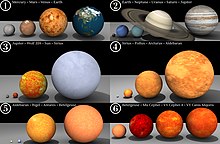Wikipedia:Picture peer review/Sizes of the planets and stars
Sizes of the planets and stars[edit]


It's a mind-blowing sequence. The viewer is invited to reflect on stars so large their size strains the limits of comprehension.
- Creator
- Dave Jarvis
- Nominated by
- StevenJohnston (talk) 21:12, 10 February 2009 (UTC)
- Comments
- In general, it really is a nice, easy to understand comparison, but I have three concerns. There's quite a lot of leniency with images citing sources, but something like this, relying heavily on statistical information, really needs a link or some sort of citation on the description page. The credit at the bottom of the image also belongs on the description page, not as part of the image itself. Finally, I'd check the projection type for the map used on Earth; it looks stretched. For something like this, you need to use an orthographic projection. If those three things are fixed, I'd definitely consider an FP nomination. Thegreenj 23:01, 10 February 2009 (UTC)
- I agree that the Earth image is a bit squashed. I think it was done that way to avoid preferentially showing one hemisphere rather than another. I've had a little attempt at replacing the earth disc by a satellite image of the earth (see, for example, the images on blue marble article) but it doesn't look quite right because the lighting in the real-world image is from the side (if you have the north pole at the top) but in the image here it'd need to be lit from above to fit in with the other planets on the row. One alternative would be to put a real-world image with the north-south axis skewed to one side but I think that people wouldn't like that just as much as the squashed image. My image manipulation expertise don't extend to wrapping a map (from here for example) onto a sphere and then lighting it from above to get the shadow to look right. It should be simple enough to do using some 3D image software but I'm unable to do it myself. Anyone else? StevenJohnston (talk) 12:42, 11 February 2009 (UTC)
- It looks to me like most (if not all) planets have errors in the texture mapping causing distortion of the surface features. Mars' polar surface features are too large, Venus, Earth and Uranus have an incorrect planar texture mapping and Jupiter's texture is distorting all features to half their width horizontally. These problems would all be easy to fix with the original 3D file... - Zephyris Talk 21:34, 11 February 2009 (UTC)
- I've linked to an updated and improved version that coincidentally addresses almost all of the issues that have been raised. Opinions please. StevenJohnston (talk) 17:57, 12 February 2009 (UTC)
- Seconder
